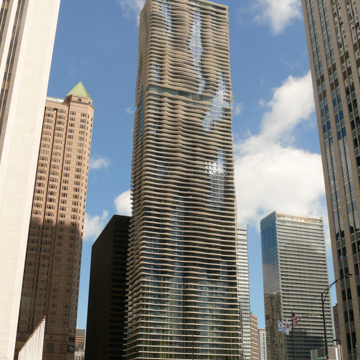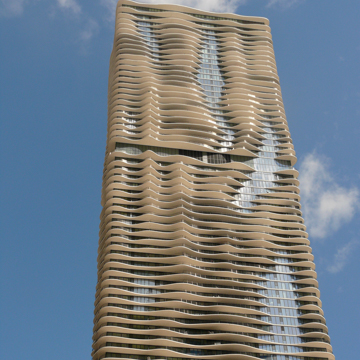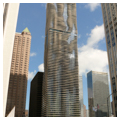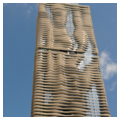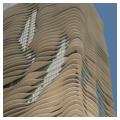Built on the western edge of the former Illinois Central Railroad yard, two blocks north of Millenium Park, Aqua is the most architecturally distinguished of more than a dozen high-rise mixed-use structures built in the Lakeshore East neighborhood since development of the 28-acre parcel began in 2001. The 82-story, mixed-use high-rise accommodates commercial and office space, a hotel, and luxury condominiums.
A conventional rectilinear, glass-enclosed structure with a wide base, Aqua is differentiated from its more conventional neighbors by undulating balconies that protrude from the taut envelope. Architect Jeanne Gang’s balconies pierce that uninterrupted verticality with surging horizontal concrete planes. Serving as sun shades and wind blocks, the resulting balconies are supremely functional, while also providing the building with an unusual, innovative expressionism. These balconies were inspired by the weathered stone outcroppings that Gang observed along the shores of nearby Lake Michigan, providing Aqua with an abstracted marine character referencing both its location and Bertram Goldberg’s nearby Marina City.
On the wide entry plinth, a thickened, curving porte-cochere covers the automobile drop off for the hotel on the north, while on the south, a landscaped garden covers a large hotel banquet room. The glazed tower rises from the center of the structure. Balconies on each level are unique to their specific floors, and extend out from the face of the building, curving out to a depth of twelve feet in some locations, and producing a tactile, rippling effect. The curving and varied balconies provide residents with particular views of Lake Michigan to the east, as well as the city rising to the north, south, and west. In areas without balconies, the blue-glazed envelope is revealed in irregular pond-shaped areas of glazing that is treated with reflective film to heighten the drama of the expression. Observed individually, the balconies are thin, apparently fragile structures, sinuously hovering out beyond the face of the building, while taken as a mass they become reef-like and powerful in their mass.
Aqua is perhaps the tallest building ever built by a woman-led firm, Studio Gang, which served as design architect for the building with Loewenberg and Associates as the architect of record working with the Magellan Development Company. With a large green roof, sun-shading balconies, UV-reflective glazing, and Chicago’s first public electric-vehicle charging station, Aqua also reflects a contemporary concern with sustainability. An exciting rethinking of the possibilities of the glazed skyscraper and the value of good design in commercial development, Aqua is as important for its potential influence as for its observed impact. Marrying good design and profitable development, Aqua will hopefully inspire other real estate investors to erect thoughtful, innovative buildings.
References
Goldberger, Paul. “Wave Effect: Jeanne Gang and architecture’s anti-divas.” The New Yorker, February 1, 2010.
Sharoff, Robert. “How a Park Changed a Chicago Neighborhood,” New York Times, June 4, 2006.
Stephens, Suzanne. “Curves over Chicago: Aqua, a new 82-story residential tower and hotel near Lake Michigan, adds a new dynamism to the city’s skyline.” GreenSource, January 2010.

